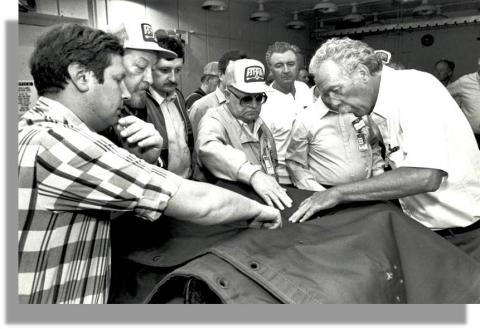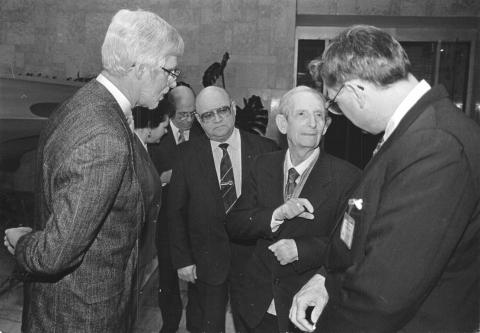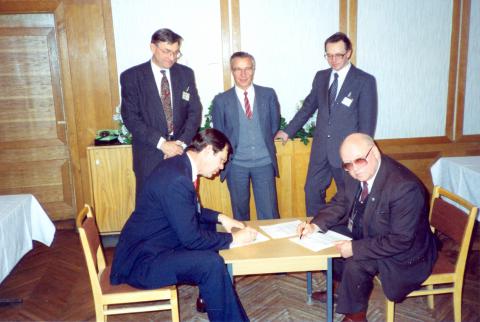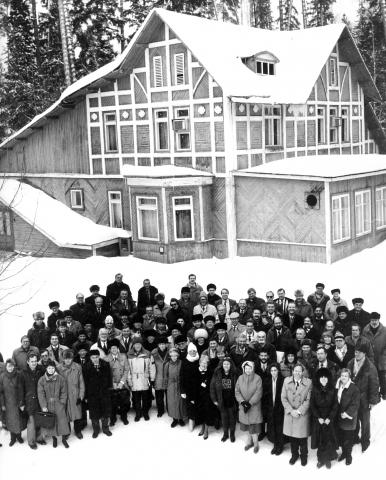Lab-to-Lab: US-Russian Lab-to-Lab Collaboration Story [Archived]
- Home
- Joint Verification Experiment
- Science Collaboration
- Nuclear Materials
- Nuclear Weapons
- Nuclear Experts
- What’s New
- Find more: WSSX: View from Sarov Photo Gallery
- WSSX: View from Snezhinsk Photo Gallery
The first direct “engagement” between US and Russian nuclear weapons experts in initiatives involving the safety and security of nuclear warheads occurred under the auspices of the Nunn-Lugar Cooperative Threat Reduction (CTR) legislation in 1991-1992. Following the signing of the Lisbon Protocol in May 1992, an umbrella CTR agreement between Russia and the United States of June 1992 and subsequent implementing agreements addressed the safe transport of warheads from former Soviet states to Russia and the subsequent dismantlement and storage of the warheads and their nuclear materials. Although these were intergovernmental agreements, it was laboratory experts who hammered out their technical details. In the course of this work, US experts gained a great deal of respect for their Russian partners. Personal relationships established during this period helped nurture the trust that became the foundation for future collaborative efforts.

Demonstration to the Russians of the Kevlar armored blankets. Sandian Carl Schuster (right) is pointing to a bullet impact that did not penetrate the blanket. Georgy Tsyrkov (Minatom) wearing an ARG (Accident Response Group with a broken arrow on it) hat is in the center with German Smirnov (VNIIA) partially visible behind his back. Other people are Sandians and the Russian military. Sandia live fire facility, May 1992
The CTR program established a vital pathway for assistance to Russia, but a more specific framework was needed to authorize the no less essential technical exchanges related to the safety and security of nuclear weapons. This was accomplished with the signing in December 1994 of WSSX Agreement which entered into force on June 1, 1995. Implementation of WSSX built on the experiences of the JVE, Geneva Testing Talks, and the early lab-to-lab science, surety and materials protection engagements all of which allowed the technical experts to develop common vocabulary and open channels of communication.
With WSSX activities already underway, Presidential Decision Directive/NSC-47 of March 1996 framed the approved areas of cooperation in nuclear stockpile stewardship and guided later meetings between US and Russian government and laboratory representatives. The program of cooperation envisioned in PDD/NSC-47 was ultimately expressed bilaterally in what became known as the Moscow Reis-Ryabev Protocol of June 1996. This document established the basis for cooperation in three areas: computations, experiments, and materials; nuclear weapons safety and security; and CTB monitoring and verification.
Ten years of engagement under WSSX (1995-2005) included workshops, technical exchanges, presentations, studies, and discussions on the safety and security of nuclear warheads that were extremely beneficial to both the United States and Russia. The scope of WSSX was again broadened following the events of September 11, 2001. The day after 9/11, Russian specialists sent letters to their counterparts expressing regret and offering solidarity. The two countries quickly decided to cooperatively develop advanced detection and response technologies to address the nuclear threats posed by terrorist groups. Over 36 projects related to counterterrorism were proposed and executed under the WSSX agreement.

Participants in the first Surety Technology Symposium, held at RFNC-VNIITF (Snezhinsk) from 29 September – 4 October 1993. Picture taken in the nuclear weapons museum at RFNC-VNIITF.
In the end, successful interaction on such sensitive topics depended ultimately on personal trust, on personal commitments that transcended any formal arrangements. WSSX was made possible by a history of bilateral interaction across a range of other programs and events and by frank discussions among nuclear weapons experts who had come to know and trust each other through these earlier experiences. These trusting relationships and WSSX-enabled communication channels made it possible for our two countries to consult each other about important safety and security matters, whether related to fires near nuclear facilities, particular warhead dismantlement difficulties, or other issues.

David Nokes (SNL) and Paul White (LANL) meet with Yuli Khariton during the second Surety Technology Symposium, held at RFNC-VNIIEF (Sarov) on 27 January 1994. Georgy Tsyrkov of Minatom is in the background.
In the words of a participant
The individuals involved in forging and maintaining these channels are getting on in years. Some are retired, and some, sadly, are no longer with us. Without an available WSSX venue, a new generation of experts is not being introduced to such forms of mutually beneficial technical cooperation. New trusting relationships necessary for the discussion of sensitive matters are not being formed and exercised. It can only be hoped that, should the need arise, the two countries will somehow find equally effective ways to turn to each other for needed expertise.
David Nokes, SNL and Paul C. White, LANL

David McConagha (DOE) and Georgy Tsyrkov (Minatom) sign a Protocol of the Meeting at VNIIA in February 1994. David Nokes (SNL), Yuri Barmakhov (VNIIA) and German Smirnov (VNIIA) are in the background.
Find it in the book
In Chapter 3 of Volume I, find detailed accounts and fascinating side stories by Paul C. White (LANL) and K. David Nokes (SNL), German A. Smirnov and Andrey S. Sviridov (VNIIA), Greg Mann, Andrey Sviridov, and Konstantin Zimovets (SNL-VNIIA), Rodion I. Voznyuk (VNIITF), Jefferey H. Richardson (LLNL), John Ruminer (LANL), and Vladimir A. Afanasiev (VNIIEF).

Participants in the Third Surety Technology Symposium, held at at RFNC-VNIIEF (Sarov) 26 January – 2 February 1994. This was the first ever visit to Sarov for the 23 U.S. participants in the Symposium. Photo taken outside the ‘House of the Scientists’ where the meetings were held.
Documents
CTR Umbrella Agreement. June 1992 The original text of the “Umbrella” Agreement Between the United States and Russia Concerning Assistance for Weapons Dismantlement in Russia (The “Safe, Secure, Dismantlement” (SSD) Program), signed June 1992.
Protocol of meeting between VNIIA/Minatom and US nuclear labs/DOE. February 10, 1994. The protocol registered “mutual interest” in cooperation in the fields of commercial applications for detection and diagnostics, nuclear materials accounting and control, industrial explosive and medical technology. The sides agreed to appoint coordinators and to convene the next meeting, “subject to approval by both sides’ governments,” in April or May of 1994.
WSSX Agreement December 1994. “Agreement between the Government of the United States of America and the Government of the Russian Federation on the Exchange of Technical Information in the Field of Nuclear Warhead Safety and Security”. Moscow, December 16, 1994.
PDD/NSC-47. March 21, 1996 Presidential Decision Directive on “U.S. policy on nuclear scientific and technical cooperation with Russia related to stockpile safety and security and CTBT monitoring and verification.”
